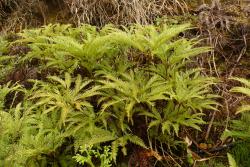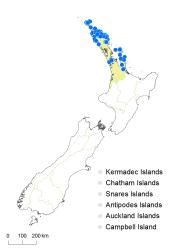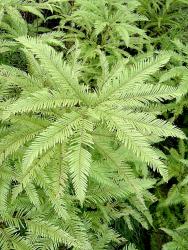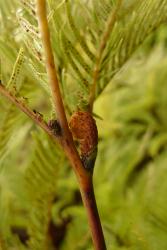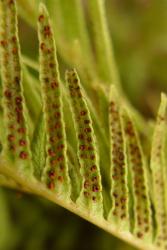- ≡ Gleichenia flabellata R.Br., Prodr. Fl. Nov. Holland. 161 (1810)
- ≡ Mertensia flabellata (R.Br.) Poir., Encycl. Suppl. 3, 670 (1814)
- = Gleichenia littoralis Colenso, Trans. & Proc. New Zealand Inst. 16: 344 (1884)
Rhizomes long-creeping, 2.5–6 mm diameter; rhizome scales lanceate or ovate, 1.3–2.6 mm long, 0.3–0.8 mm wide, brown, ciliate, sometimes only shortly so. Fronds 180–1490 mm long. Stipes 55–1100 mm long, scaly proximally or glabrous. Laminae 90–770 mm long, 100–450 mm wide, green on both surfaces, herbaceous, scaly. Rachis buds not extending or extending once (rarely 2–3 times), scaly; not pseudostipulate. Rachis bud scales lanceate or ovate, 1.2–2.6 mm long, 0.2–0.7 mm wide, brown, ciliate. Pinnae 95–400 mm long, 120–260 mm wide; with 2–3 (rarely 1) successive pseudodichotomous forks (excluding growth from pinna buds); pinna buds not extending or rarely extending once or twice. Proximal-most (primary) costae 6–20 mm long, with 0–1 pairs of costal segments. β costae 13–75 mm long, with 3–23 pairs of costal segments. Ultimate leaflets narrowly ovate or narrowly elliptic, 100–280 mm long, 20–80 mm wide, usually at least some caudate (otherwise angustate), usually mostly straight; with 24–52 pairs of ultimate segments; pairs in centre of lamina diverging 20–40° (rarely 45°). Abaxial surface of α costae scaly; scales acicular or hair-like, 500–1600 µm long, 30–90 µm wide, pale, ciliate, glabrescent. Ultimate segments narrowly oblong or linear, 14–55 mm long, 1.5–2.5 mm wide, arising at 40–65° from α costae, crenulate, acute; abaxial surface with pale stellate scales that resemble branched hairs, glabrescent. Sori 7–18 either side of midvein, usually with 4–5 sporangia each. Spores 32–35 µm long, 17–19 µm wide (4 populations).
The crenulate and abaxially green ultimate segments, usually caudate leaflets, acicular or hair-like scales on the abaxial surface of the α costae, and the ultimate segments arising at ≤70° from the α costae distinguish Sticherus flabellatus from S. cunninghamii and S. tener. Sticherus flabellatus is very similar to S. urceolatus, but the former usually has longer α costae relative to the proximal-most costae, and more pronounced serrations of the ultimate segments. The difference in ploidy is reflected in the smaller spore size of S. flabellatus (32–35 µm long, 17–19 µm wide cf. 38–43 µm long, 19–23 µm wide for S. urceolatus). In New Zealand, S. flabellatus (northern North Island) and S. urceolatus (northern and western South Island) are allopatric.
North Island: Northland, Auckland.
Altitudinal range: 0–370 m.
Sticherus flabellatus occurs from North Cape to near Waihi in the North Island. The highest recorded altitude of c. 370 m above sea level occurs in Puketi Forest. Collections from further south are discounted because they are probably incorrectly labelled or from cultivated plants (Ōpōtiki, Baxter s.n., WELT P018468; Ōpepe, collector unknown, WELT P005416; Mt. Freeth, Picton, McMahon s.n., WELT P010704). The South Island records from near Tākaka and Stockton discussed by Given (1982) are misidentifications of other Sticherus species (Brownsey et al. 2013).
Also New Guinea, Australia (Northern Territory, Queensland, New South Wales, Victoria), New Caledonia.
Sticherus flabellatus frequently occurs alongside waterways, roads, and tracks, but also on bluffs, and in swamps, gumlands, and other habitats associated with high light levels. It is usually associated with scrub or low, open forest, principally Leptospermum and/or Kunzea, but it can occur in gaps within Agathis australis, podocarp, and/or broadleaved (e.g., Weinmannia, Beilschmiedia) forest.
Sticherus flabellatus hybridises, albeit infrequently, with S. cunninghamii, based on morphological intermediacy (e.g., abaxially glaucous, but with caudate leaflets, and scales on the abaxial surface of the α costae of intermediate width): unlocalised, Colenso s.n., WELT P002888, P002890, P002891, P002897, P002905; Whangarei, A.J. Dakin s.n., AK 213848; Great Barrier Island, A.E. Wright s.n., AK 220418. The spores of WELT P002891 include a high proportion of irregular shapes, supporting the inference of hybridity. Furthermore, S. flabellatus may be a diploid progenitor, together with S. tener, of the tetraploid and putatively allopolyploid S. urceolatus (Brownsey et al. 2013).
n = 34 (Brownlie 1961)
Chinnock & Bell (1998) accepted two varieties in Australia, distinguished by segment and sporangia size. The typical variety was attributed to New Zealand. The other variety, var. compactus (C.T.White & Goy) D.A.Sm., is endemic to northern Australia.
In relation to Gleichenia littoralis Colenso, the statement by Allan (1961, p.21) that "Colenso based his description on the Great Barrier specimens; the type specimen, at W [WELT]…" constitutes lectotypification because there is only one collection in WELT from Great Barrier Island (WELT P003359). It comprises three fronds. The other syntypes are: New Zealand, W. Colenso s.n., com. Dec. 1885, K! (photo WELT E471/9); Whangaruru Harbour, W. Colenso s.n., WELT P002907!



